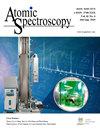激光诱导击穿光谱法对煤和杂物质的分步分类方法
IF 2.3
2区 化学
Q1 SPECTROSCOPY
引用次数: 0
摘要
煤中常见的各种物质,包括脉石、塑料和木材。这些杂项物质影响了电厂用激光诱导击穿光谱分析煤的可靠性,但与煤具有明显不同的光谱特性。因此,本文提出了一种分步分类的方法来筛选杂类材料的假光谱。第一步旨在通过使用标准偏差(SD)值确定特定特征谱线的存在来识别塑料和木材光谱。分别以Si Ι 288.16 nm和Li Ι 670.78nm两种光谱线作为鉴别标记,其SD值均大于850次。第一步的分类准确率为100%。由于脉石与煤具有较高的相似性,第二步采用随机森林(RF)分类模型对脉石光谱进行识别。对模型中的树数和随机变量数进行了优化。采用分步法和不采用分步法的分类模型的准确率分别为98.30%和99.96%。为了评估光谱分类的必要性,通过添加不同比例的假光谱进行了一组热值分析,并与去除假光谱后的分析结果进行了比较。预测结果的均方根误差(𝑅𝑀𝑆本文章由计算机程序翻译,如有差异,请以英文原文为准。
A Step-By-Step Classification Method Of Coal And Miscellaneous Materials By Laser-Induced Breakdown Spectroscopy
: The miscellaneous materials, including gangue, plastic, and wood commonly present in coal. These miscellaneous materials affect the reliability of coal analysis using laser-induced breakdown spectroscopy in power plants, but have significantly distinct spectral characteristics from coal. Hence, this paper proposes a step-by-step classification method to screening the false spectra of miscellaneous materials. The first step aims to identify the plastic and wood spectra by determining the existence of specific characteristic spectral lines using the standard deviation (SD) values. The spectral lines Si Ι 288.16 nm with the SD value of more than 850 counts and Li Ι 670.78nm with SD value of more than 1750 counts were used as the distinguishing markers. The classification accuracy of first step was 100%. Due to the high similarity between gangue and coal, the second step utilized the random forest (RF) classification model to identify the gangue spectra. The number of trees and random variables in the RF model was optimized. The accuracy of classification model without and with the proposed step-by-step method was 98.30 and 99.96%, respectively. To assess the necessity of spectra classification, a set of calorific value analysis was performed by adding false spectra of different proportions, which were compared with analysis after removing the false spectra. The root mean square error of prediction ( 𝑅𝑀𝑆𝐸𝑃 ) was 0.42 MJ kg -1 (after removing), compared with 0.50 MJ kg -1 (mixing with 10% gangue spectra), 0.56 MJ kg -1 (mixing with 20% gangue spectra) and 0.57 MJ kg -1 (mixing with 30% gangue spectra). The results demonstrated that the proposed step-by-step classification method could effectively identify the spectra of coal and miscellaneous materials and improve the accuracy of coal analysis.
求助全文
通过发布文献求助,成功后即可免费获取论文全文。
去求助
来源期刊

Atomic Spectroscopy
物理-光谱学
CiteScore
5.30
自引率
14.70%
发文量
42
审稿时长
4.5 months
期刊介绍:
The ATOMIC SPECTROSCOPY is a peer-reviewed international journal started in 1962 by Dr. Walter Slavin and now is published by Atomic Spectroscopy Press Limited (ASPL). It is intended for the rapid publication of both original articles and review articles in the fields of AAS, AFS, ICP-OES, ICP-MS, GD-MS, TIMS, SIMS, AMS, LIBS, XRF and related techniques. Manuscripts dealing with (i) instrumentation & fundamentals, (ii) methodology development & applications, and (iii) standard reference materials (SRMs) development can be submitted for publication.
 求助内容:
求助内容: 应助结果提醒方式:
应助结果提醒方式:


